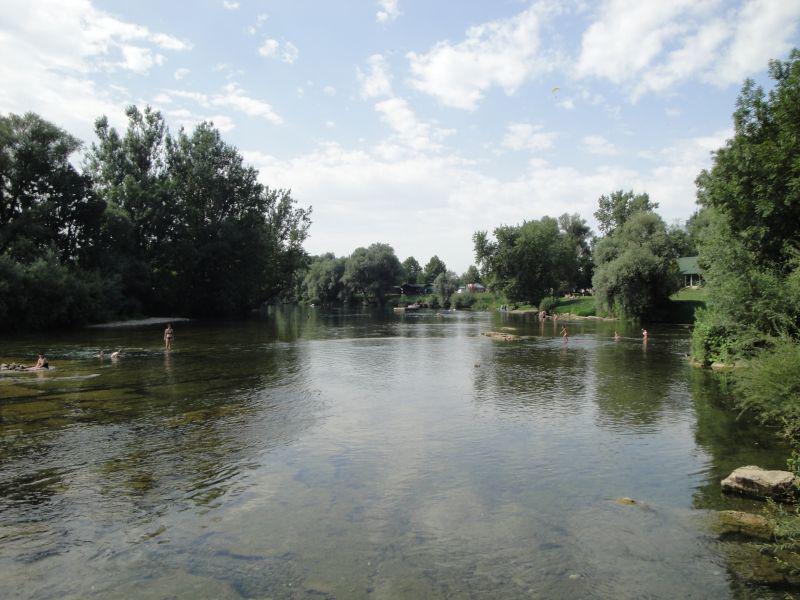
The Kolpa forms a natural border between Slovenia and Croatia for 118 km, and separates Central Europe from the Balkans. It runs from Osilnica, through Kostel, Kočevje, Črnomelj and Semič to Metlika. The Kolpa and Kolpa valley are the main attraction and asset of the Kolpa Landscape Park, which covers the area between Stari trg and Dragoši. On its course through the park, the river changes its character several times. In some parts, the river's channel widens and the flow of water slows down, while in another part, the river runs wildly through the narrow canyon.
Rich flora and fauna
The Kolpa provides a favourable habitat for many rare and endangered animal species, in particular for the otter and the European pond turtle. The Kolpa area is also home to many bird species, including the grey heron, which is the most common, and most outstanding are the mighty white-tailed eagle and the goosander. The river is home to over 30 species of fish, some of which cannot be found in any other body of water in Slovenia.
The park's special feature is a typical cultural landscape characterised by steljniki (stands of birch trees with bracken undergrowth) and typical karst features such as karst dolines and terraces. This area has significant value in terms of nature protection, and a rich biodiversity and landscape diversity. Is has diverse natural features – individual trees of exceptional dimensions or groups of important trees, valleys, karst caves, springs, steljniki, and dolines. The park has a total of 71 natural features, of which 16 are natural monuments. Hrastova Loza, a stand of beeches with nesting sites of the grey heron, is a strict nature reserve – the only one in Slovenia. Marindolski Steljniki, preserved steljniki and overgrown areas near Marindol, is both a natural and cultural monument and as such a great rarity.
Due to the area's remote location and the impassable terrain, the flora has remained relatively untouched and is dominated by natural forests and partly even virgin forests. The cultivated land, particularly grasslands and pastures, has preserved its unique features. The park is home to Illyiran plants (plants that grow in the area of the former Roman province of Illyricum), sub-Mediterranean plants, Alpine plants and wetland plants. Various species of orchids grow in the meadows. The Kolpa is one of the Natura 2000 sites of international importance.
Nature protection
The Kolpa Landscape Park is divided into three conservation areas. Protection is strictest in the first conservation area, which encompasses alluvial plains (a slightly sloped area or undulating land created by the deposition of sediment during periodic floods) along the river Kolpa, the river itself, steep and gently sloping riparian areas and areas with important natural features. The second conservation area encompasses mostly agricultural and forest areas, where the natural balance has been preserved due to the traditional use of land, and a cultural landscape typical of these parts has been formed. It also includes recreation areas. The third conservation area includes villages with traditional orchards, larger settlements and certain wine-growing areas.
The main purpose of establishing the protected area of the Kolpa Landscape Park was to preserve natural features, biodiversity and landscape diversity and implement measures to ensure the conservation of Natura 2000 sites and areas of ecological importance. The park also has the purpose of integrating economic and social development in the park area and cross-border cooperation.
"The expert basis for taking protection measures is monitoring and supervision in the protected area," says Boris Grabrijan, the Director of the Kolpa Landscape Park. They also educate and encourage the wider public to be environment-friendly when in the park. "The protection measures also include school pupils' involvement in making bird hatcheries and monitoring bird populations, clean-up campaigns, taking care of habitats and the protection of species, the promotion of environment-friendly tourism, farming and other economic activities," stresses Mr Grabrijan.
Rich cultural heritage
The park conserves and is home to a rich cultural heritage. Some of the interesting things to see are the distinctive enclosed rectangular homesteads known locally as "dvori", which consist of a residential part, barn, stable and inner yard; plus there are castles and many mills and sawmills along the Kolpa.
One of the park's important projects is the Kolpa eco-etno project (ecological and ethnological activities along the Kolpa). Its aim is to preserve the rich ethnological heritage of the local environment, and is based on ecological principles. The Šokec farm (Šokčev dvor), a protected cultural monument, has been renovated and Kolpjanke Villas, small wooden glamping houses on sleds, have been built by Kolpas d.o.o. as part of the project. The mobile houses are a small model of a traditional Bela Krajina house and granary. They are made of natural, traditional materials: spruce wood, wool from the Slovenian native sheep breed 'belokranjska plamenka', Adlešiči flax and hemp.
Visit the enticing Kolpa and its surroundings
In the Kolpa Landscape Park, you are welcome to visit the Šokec farm, an open-air museum that features a typical Bela Krajina farmhouse, where guests are greeted by the locals in traditional Bela Krajina clothes and served Belokranjska pogača (salted cake) and a glass of home-made drink. The local people are already familiar with the hospitality of Bela Krajina and the beauties of the Kolpa, whose magnificent scenery attracts an increasing number of foreign tourists.
Danila Golob, SINFO

































































